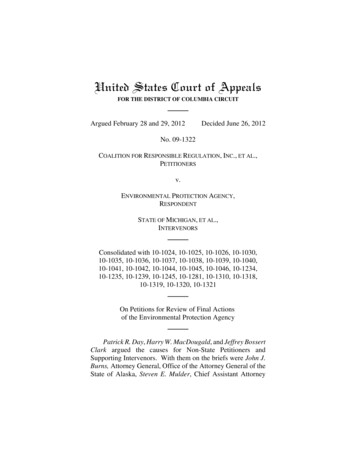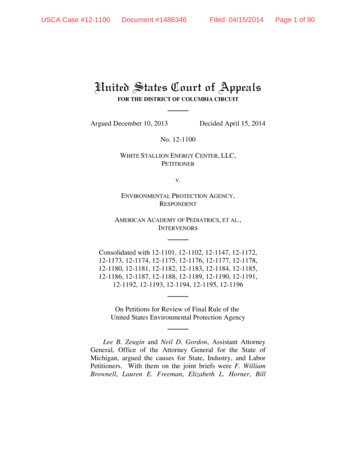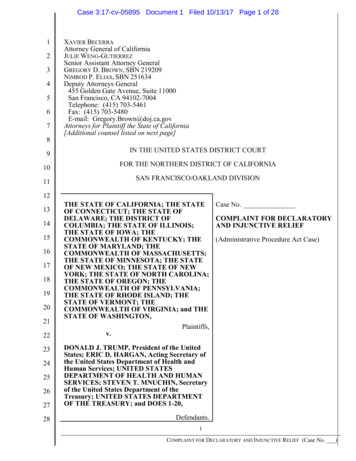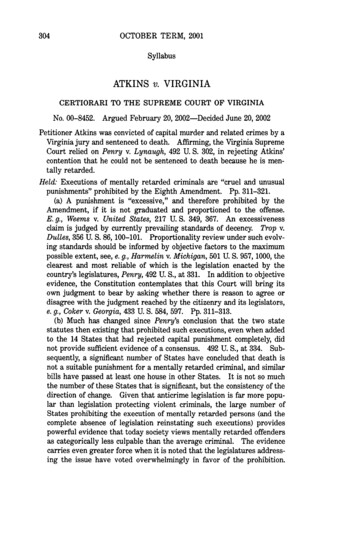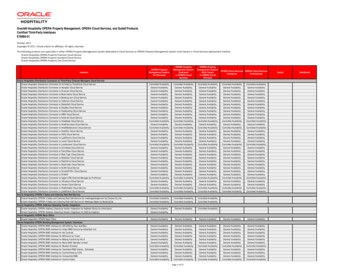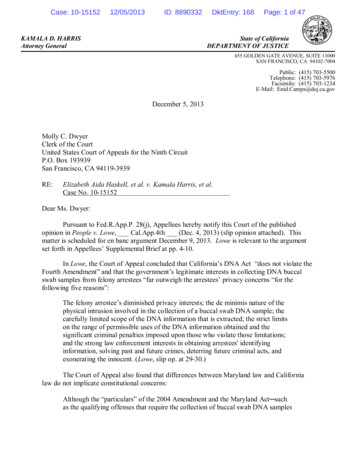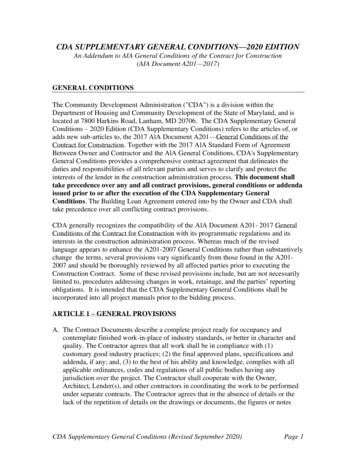
Transcription
INFORMATION SYSTEMS SERVICESGuide to the Design of QuestionnairesA general introduction to thedesign of questionnaires forsurvey research.AUTHOR: Dr Thomas F BurgessDATE: May 2001EDITION: 1.1TOP 2UNIVERSITY OFLEEDS75p
Contents1Introduction12Define Your Research Aims33Identify the Population and Sample44Decide How to Collect Replies55Questionnaire Design66Run a Pilot Survey157Carry Out the Main Survey168Analyse the Data179References18Appendix 1Examples of Question Design19Appendix 2Examples of Questionnaires22AcknowledgementsThe author of this document is Dr Thomas.F.Burgess, Senior Lecturer - Operations& Technology Management, University of Leeds.Format ConventionsIn this document the following format conventions are used:Commands that you must type in are shownin bold Courier font.Menu items are given in a Bold, Arial font.Keys that you press are enclosed in anglebrackets.WIN31Windows Applications Enter FeedbackIf you notice any mistakes in this document please contact the Information Officer.Email should be sent to the address info-officer@leeds.ac.ukCopyrightThis document is copyright University of Leeds. Permission to use material in thisdocument should be obtained from the Information Officer (email should be sent tothe address info-officer@leeds.ac.uk)Print RecordThis document was printed on 11-Jul-03.1
1IntroductionAbout This DocumentThis document is designed for students and novice researchers intending tocarry out a questionnaire survey. Because surveys of any kind are expensiveand time-consuming to conduct, it is important that the data analysis is asextensive and well prepared for as possible. The strength of the analysisdepends on good quality data that in turn stems from good design of the datacollection instrument, i.e. the questionnaire, and of the collectionprocedures.This document provides a compilation of do's and don'ts for goodquestionnaire design that will, if followed, make data analysis easier andfaster than otherwise. The survey process is outlined to place questionnairedesign in context. Also covered in this document are a number of ways inwhich the computer fits into various elements of the overall survey process.SurveysThe basic process of survey research can be outlined as follows:1. define your research aims2. identify the population and sample3. decide how to collect replies4. design your questionnaire5. run a pilot survey6. carry out the main survey7. analyse the dataA crucial part of good research design concerns making sure that thequestionnaire design addresses the needs of the research. To put thisanother way; somehow we need to ensure that the questions asked are theright ones. To move from the research aims (1) to deciding what are the rightquestions to put on a questionnaire (4) is a key aspect that needs to beaddressed by the researcher. This document makes some comments aboutthis important area but does mainly concentrate on the mechanics ofdesigning the questionnaire.Unfortunately too many researchers complete the data collection (6) beforethey have given sufficient thought to the data analysis (7). This can lead toinadequate data and inadequate inferences from the data, and candisappoint and frustrate the researcher. Ideally the method of analysisshould be known, and it should inform the preceding stages of the research.The statistical software to be used in the analysis is certainly an importantconsideration at the questionnaire design stage; however, many of therelevant packages have common needs that are addressed in this handout.Information Systems Services supports a range of statistical packagesincluding SAS, Minitab and SPSS, and they can advise on the best programfor your requirements.Comments are made in the following sections on each of the seven stepslisted above, but with the emphasis on point 4 in this sequence. Anadditional concern of this document is using the computer to support theprocess. The computer will normally save you time and should result in1
greater accuracy and lower probability of many kinds of errors. If you usethe computer on a task for the first time then some extra time may be neededto complete it but you will then have gained an important new skill.The computer can be used to help in a variety of ways. Some activities are:2 Designing and constructing the questionnaire (step 4) Identifying and keeping track of respondents (6) Delivering the questionnaire (6) Data entry and analysis (7)
2Define Your Research AimsStart your survey by setting down the aims for the survey. To define theaims for academic, as opposed to market, research you will need to reviewthe relevant literature and you may need to do some preliminary researchamongst your target subjects. Fulfilling these aims should then drive thedesign of your questionnaire and help select questions that are relevant,concise and efficient.Most researchers make the mistake of asking too many questions. This oftenarises from an incomplete analysis of how to meet the survey aims. Yourgreatest enemy in survey research may well be poor response rate. Clear andconcise questionnaires can help get the best response.3
3Identify the Population and SampleThe population is simply all the members of the group that you are interestedin. A sample is a sub-set of the population that is usually chosen because toaccess all members of the population is prohibitive in time, money and otherresources. A key issue in choosing the sample relates to whether themembers you have chosen are representative of the population. Often thesample is chosen randomly from a list that contains all the members of thepopulation; such a list is called a sampling frame. Some methods of selectingsamples, e.g. quota sampling, do not require a sampling frame.To determine the sample size it is usual to work back from how manyresponses (completed questionnaires) are required for the analysis. Onerough and ready rule is to look for about 20-30 responses in each of themajor sub-categories of the sample. For example, if a key aspect of yourresearch is to compare male and female then you should look for about 30males and 30 females in your responses. This number then needs modifyingby the anticipated response rate to determine the target sample size. It isquite common for survey response rates to be around 20%, which meanssending out five times as many questionnaires as you want returning. Forthe example above this would mean 300 questionnaires to obtain 60responses.4
4Decide How to Collect RepliesDecide whether the survey is to be completed by the respondent directly orthrough an interviewer, and design the questionnaire, and any otherdocuments, accordingly. It is important in both circumstances to explain tothe potential respondent why you believe they should answer the questions,doing so persuasively can improve response rate. Where the questionnaire isadministered by post, or e-mail or some other indirect means, it is usualpractice to provide a letter that explains what the questionnaire is about andwhy its completion is of value.Structured Interview SchedulesThis document mainly gives advice on the construction of questionnaires fordirect reply; the structured interview questionnaire can be dealt with in asimilar but slightly different way. For example, questions asked orally areusually phrased differently from those written down and it is important toinclude detailed conversational text when an interview is conducted face toface or by telephone.Self-Administered QuestionnairesRelying on the respondent to complete the questionnaire has some clearimplications for design. Respondents are more likely to commit to answer aquestionnaire when they see it as interesting, of value, short, clearly thoughtthrough, and well presented. However, even though respondents might startto fill in the questionnaire they may give up if they find it hard work tocomplete. Inducements to complete surveys can be used, e.g. offering areport of the survey findings to respondents or entry in a prize draw.It is good practice to send questionnaires to an identified individual and notsimply to, for example, “the Managing Director” or “the Personnel Manager”.It is a good idea to get a ‘foot in the door’ by asking each potential subject tocomplete a very short pro-forma, confirming a few essential details, includingname and address. You will get a higher response from this first approach;this could be done by telephone and then followed up with a fullquestionnaire by post. Introductory letters, reply paid envelopes and followup telephone calls also help to raise the response rate for self-administeredquestionnaires.Questionnaires can be delivered to the respondent by various meansincluding post, e-mail attachments or via publishing on a web site forinteractive completion.5
5Questionnaire DesignDesign of the questionnaire can be split in to three elements:a) determine the questions to be asked,b) select the question type for each question and specify the wording,andc) design the question sequence and overall questionnaire layout.Available software tends to focus on support for (b) and (c).Determine the Questions to be AskedThis step is a key one that seems not to be sufficiently stressed in theliterature or conducted in practice. A key link needs to be establishedbetween the research aims and the individual questions via the researchissues. Issues and questions can be determined through a combined processof exploring the literature and thinking creatively. A simple illustration ofthe outcome of such a process is given below.Survey aims: to explore the factors that might explain the reasons that LeedsUniversity candidates give for undertaking a MBA programme:Issue:Question focus:What reasons might candidates givefor undertaking an MBA?Is the candidate looking for:career changecareer advancementhigher remunerationetc.Could past experience affect thereasons?How many years work experiencedoes candidate have?Could gender differences affect thereasons?Is the candidate male or female?Could educational background andattainment affect the reasons?What is highest educationalqualification obtained?What subject area(s) is thisqualification in?Etc.Etc.The above process generates the focus for individual questions that can thenbe designed in detail.6
Decide on a Layout and SequenceDo not clutter the form up with unnecessary headings, and numbers.However, it is good practice to ensure that the questionnaire has a title andthat the revision or date of the version is printed on the questionnaire. (Thiswill particularly help as you take the draft through a series of revisions.) Abrief introductory statement is useful, especially if the introductory lettercould go adrift. Contact and return information should be included on thequestionnaire, irrespective of whether addressed return envelopes areprovided; these can easily become separated. Similarly it is good practice tonumber or otherwise identify individual questions for reference purposes;this is particularly helpful to deal with queries during the data entry andanalysis stage.Lay out the questions and answer choices attractively and neatly. Try to beconsistent in aspects such as wording and try to standardise by using as fewquestion types as possible. Avoid switching between landscape and portraitfor the text layout. Be careful not to overfill the page. Avoid using lots oflines, borders and boxes since these can make the page look too ‘dense’. Akey factor that affects the response rate is the length of the questionnaire;questionnaires perceived as long will deter respondents. Using a small fontcan cut down the number of pages and hence make the questionnaire lookshorter; but remember that small fonts can put people off – particularlythose with less than perfect eyesight. Use a good legible font; a serif font likeTimes is easier to read than a sanserif one like Helvetica. Make good use ofitalics and bold types: think of using italics consistently to give instructions,e.g. tick the relevant box. Consider using bold for the questions themselvesor for headings. Symbol fonts can be useful for characters such as 9If you are relying on the respondent to complete the questionnaire, beginwith questions that will raise interest. However, there are different views onsequencing of questions. For example, someone might argue that the easierquestions to answer should be at the beginning to get the respondent in tothe swing of things. However, someone else might suggest that questionsabout personal data, which are easy to answer, should be left until the endwhen the respondent has committed themselves to answering and they areless likely to object to giving such data. Whatever approach you choose youshould try to have a logical sequence, e.g. group together all questions thatrelate to similar areas.You should try to keep the flow through a questionnaire logical and verysimple, i.e. avoid complex branching. Although some questions may beconsequent upon earlier answers, keep the number of branches to theminimum. If necessary, use two or three versions of the questionnaire forrespondents in different situations.7
Question TypesDifferent types of questions can be used, e.g. open vs. closed, single vs.multiple responses, ranking, and rating.Open vs. Closed QuestionsMany advise against using open-ended questions and advocate using closedquestions. However, open questions can be useful. For example, the openquestion:What do you think are the reasons for football hooliganism?would elicit a whole range of replies of varying length and articulation. If youare interested in making very precise judgements of each individualrespondent this may well be useful. If, however, you are concerned, as mostsurveys are, in summarising replies to produce a picture of your population,a better approach may be Do you think football hooliganism is caused by: (tick if appropriate)Lack of discipline at homePlayers’ behaviour on pitchFamily breakdownYouth unemploymentPoor schoolingViolence on T.V.Other (please specify)Plan to make your categories exhaustive, i.e. covering all possibilities, bymaking fairly broad suggestions that will still satisfy your objectives.However, you could include the catch-all type option (Other) as above.If you still feel that your questions cannot be categorised until all the repliesare returned then ensure that sufficient space is included for the questionand leave a space in the margin to code a numeric response.e.g.What was the main problem you encounteredwith your wheelchair? 8
Single vs. Multiple ResponseWhen designing questions make sure you have thought through whether youwant the respondent to give a single or a multiple response. For example, ifyou ask the question:Which of the following means do you use to travel to college?BusCarBikeYou might get someone who thinks that only one box should be ticked whileanother respondent might believe they are at liberty to tick as many boxes asthey like. If you intend that the respondent treat these as a series ofindependent dichotomous yes/no questions then the question could beclarified by inserting the text “tick all boxes that apply”. Note that treatingthe question in this way would require three separate variables to be set upon the computer and for each variable coding might be 0 for no and 1 for yes.Consider the following question:What is your most usual means of travelling to college?(Tick one box only)BusCarBikeThe above should elicit one response, i.e. the answers form mutuallyexclusive categories. For the computer the above would be coded as onevariable with Bus represented by 1, Car by 2 and Bike by 3. If therespondent omitted to answer then this could be coded as 0 or some othermissing value. However, note the problem with both the above questions ifsomeone travels by train or just walks. Either all the possibilities have to beanticipated in advance or an additional box has to be offered for therespondent to tick and specify the mode of transport.Never be tempted to use the following structure:Select up to three of the options below andenter in the boxes oppositeOption AOption BOption COption DOption EOption FWhilst this may be logically sound you will have problems whensummarising these results. A very tedious and finally unsatisfactory searchis required to determine how any given option performs.9
Ranked ResponsesSometimes it is useful for the respondent to rank a set of options bynumbering them in order from 1 to the maximum number you are interestedin.For example, to a question like:Place in order of importance to you the following features of acamping holiday(Indicate by numbering from 1-4 in order where 1 is the most important)Open airMobilityCostPeopleAtmosphereNote that each option will need to be coded as a separate variable and in theabove case five variables are required (even though only four ranks are to beidentified). This approach can generate a lot of data and so the number ofoptions used should not be excessive. Apart from this respondents find itdifficult to discriminate meaningfully between lots of options.Rated ResponsesA popular approach in the social sciences is to use Likert scales such as theexample below:(Circle the number under the initials that applies.VI Very important; I Important; N Neutral; U Unimportant;VU Very Unimportant).Indicate your view of the following aspects of a camping holidayVIINUVUCommunity life12345Low cost12345Outdoor life12345Ability to move around12345Note that each of the four rows will form a separate variable that containsthe appropriate numeric code from 1 to 5.10
Decide on Question WordingSome general rules can be stated on question wording: Be concise and unambiguous Avoid double questions Avoid questions involving negatives Ask for precise answers Avoid leading questionsBe Concise and UnambiguousMake questions brief and clear. Avoid jargon; e.g. asking “do you believe thatthe UK should have upper and lower houses of parliament?” is more likely toelicit an informed response than “do you believe that the UK should have abicameral parliament?”Check for ambiguity and make sure that the answer may be competentlyanswered. E.g. asking “have you been to the cinema recently” is moreambiguous than “have you been to the cinema in the last two weeks?”Avoid Double QuestionsSometimes questions hide a dual question, for example:Do you think the British should eat less and exercise more?instead ask:(Please circle relevant number)YesNoDo you think the British should eat less12Do you think the British should exercise more12Notice the consistent use of circled number responses for Yes/No questions.Avoid Questions Involving NegativesDon't confuse the respondent by language like this:(Please circle relevant number)Are you against a ban on smoking11YesNo12
Ask for Precise AnswersAsk for precise answers if you think the information is available and thereare no other constraints (e.g. too intrusive on privacy). For example:yearsGive your age on lst September 2001is preferable to:Are you Under 1818-65Over 65In this example although age groups may be all that is required, asking forthe exact age will also suffice and have the added advantages that: There is less room for error, i.e. ticking the wrong box. Exact ages may very simply be recoded, by a computer program, intogroups. The researcher can alter these groups by keeping the exact ages. Notonly could you inspect different age groups than at first envisaged,but you could backdate your age groups. You can obtain continuous descriptive statistics, e.g. mean andstandard deviation.Using a computer you can transform dates of birth into ages as long as youhave the date on which the information was given. Of course an obviousadvantage of offering groups to the respondent is that it can reduce the timetaken to complete the question or, in some cases, improve the response rateto that particular question.Avoid Leading QuestionsLeading questions such as “Do you agree with the majority of people that thehealth service is failing?” should be avoided for obvious reasons that anyright-minded individual can see. Don’t you agree?12
Using the Computer to Design and Construct theQuestionnaireStandard applications, such as a word-processing package, can help indesigning and producing professional-quality questionnaires. However,specific packages are available that support the design (and subsequentanalysis) of questionnaires, e.g. Snap by Mercator SphinxSurvey by Scolari (Sage) Merlin Software by MerlincoIn fact there is a wide range of products and services available, many via theInternet. A good list of what is available can be obtained fromwww.yahoo.com on their pages: Business and Economy Companies Computers Business to Business Software Surveys and PollingSome further web resources that also have lists of available software arelisted later in the references section. Apart from design software that youcan buy to run on your computer, some companies offer software andservices for free; but these are often tied to the company’s proprietary dataentry and analysis processes that you must pay to use. This is particularlythe case where companies host the questionnaire on their web site forrespondents to fill on-line. Notwithstanding these comments, such packagesmay also enable survey data to be imported and exported in SPSS and otherfile formats, e.g. survey interchange standard. If you can pay, companies willprovide a full service from design through to analysis.For the adventurous or the adept HTML author, a questionnaire can be builtusing HTML and CGI script to publish on a website (see e.g. chapter 11 onforms in Castro, 2000).13
Confidentiality and EthicsFirstly allow for privacy and do not ask questions which may offend, or askfor data that is not essential. Apart from anything else, your response ratewill suffer.Secondly, especially if you need to ask some personally searching questions,it helps to explain as much as you are able about your research to therespondent, both at the beginning and throughout the questionnaire.For example having asked most of your general questions you might at theend write:Finally could you give us a few bits of informationabout yourself so that we can put your other replies ingreater context.Age in yearsSex:MaleFemaleand so on.In surveys promises of confidentiality are often made to the respondents toreassure and encourage replies. The researcher should comply with any suchpromises. However, it might help to explain to the potential respondent whatis meant rather than give a blanket assurance of confidentiality, e.g. “yourresponses will be treated with confidence and at all times data will presentedin such a way that your identity cannot be connected with specific publisheddata”. This is still compatible with publishing, with respondents’permissions, a list of participants who have co-operated in the survey.In connection with issues of privacy researchers should be aware that theData Protection and Human Rights legislation has implications for privacyand confidentiality of survey data. For example, researchers should only usedata for the purposes that were declared on the questionnaire. Where thedata is particularly sensitive or substantial you may want to include astatement in the questionnaire granting permission for the data to be used inconnection with the research and ask respondents to sign. Apart from thelegal issues, it is unethical to obtain data from respondents by misleadingthem about the survey purpose and the method of analysis.14
6Run a Pilot SurveyTest the questionnaire on a small sample of your subjects first. If this is notpossible, at least test it on some colleagues or friends. The aim here is todetect any flaws in your questioning and correct these prior to the mainsurvey. The piloting may enable you to convert an open-ended question in toa closed question by determining the range of possible answers. You mayalso be able to perform a trial analysis on your pilot sample and hence testout all your analysis procedures.Having done your pilot survey, you can make amendments that will help tomaximise your response rate and minimise your error rate on answers.15
7Carry Out the Main SurveyIdentify Respondents and Keep Track of StatusComputer databases are available that enable you to pinpoint particulartypes of organisations and individuals. Sometimes it is worthwhile to pay alist-broker to provide a specific list (sampling frame). A simple database isuseful to keep track of when questionnaires were sent out and to whom. Thiscan be updated with details of follow-up contact and dates of reminders.Number Each QuestionnaireEach individual questionnaire must be uniquely identified by you, preferablybefore it is distributed or, to preserve anonymity, afterwards. Thisidentification could be via a number, or letters and numbers, e.g. if you wantto use area codes as part of an identifier. This code should be transferred toall the computer records that will be produced from your questionnaire. Theunique code enables you to match computer records with completedquestionnaire form and thus allows you to check queries back to individuals.Deliver the QuestionnaireHere you follow through on the decisions made earlier about how thequestionnaires should be administered and who the recipient should be.Deadlines for distribution should have been decided earlier with allowancesfor sending out reminders or carrying out follow up calls.16
8Analyse the DataA precursor to analysis is the coding, entry and checking of data. Somecomments were made earlier about the statistical analysis packages that areavailable (e.g. SAS, Minitab and SPSS). In all instances data can either beentered direct or imported from other packages such as Excel, provided theinstructions for the receiving package are adhered to. In all cases a similarapproach is used for coding and formatting data.Usually the data is help on the computer in a rectangular data table whereeach row represents a ‘case’, i.e. a specific respondent and their data. Eachcolumn represents a specific variable, i.e. the data for that variable for allrespondents. Note that a question on the questionnaire may require morethan one variable to specify the data collected by that question.A variable will have a unique title and a specific level of measurement. Themeasurement level of a variable is important because it determines the typeof analysis that can be undertaken. In ascending order of sophisticationthese levels are:Nominal, Ordinal, Interval and Ratio(Note in SPSS the Inteval and Ratio levels are grouped together and calledscale.)For ease of data handling and analysis the values that variables can take areusually designated by numeric codes, even when the variable is a nominalone. For example, gender can take the value male or female, but wouldusually be coded O and 1 (or 1 and 0) for ease of handling. Putting thesedata entry codes on the distributed questionnaire can help at data entrytime, but obviously has the downside of putting numbers on thequestionnaire that are of no relevance to the respondent and therefore couldmake the questionnaire look messier than it needs to.Analysis packages usually make arrangements for missing values to becoded automatically; if they do not, this will have to be specifically taken careof when entering data.17
9ReferencesBooksBynner, J. and Stribley, K.M. (eds.) (1978) Social Research: Principles and Procedures,Longman/ Open University Press.Castro, E. (2000) HTML for the World Wide Web, Peachpit Press.Foddy, W. (1994) Constructing Questions for Interviews and Questionnaires, CambridgeUniversity Press.Oppenheim, A.N. (1968) Questionnaire Design and Attitude Measurement, Heinemann.Sharp, J.A. and Howard, K. (1998) The Management of a Student Research Project, Gower.de Vaus, D.A. (1990) Surveys in Social Research, Unwin Hyman.Web-sitesQuestionnaire Design and desgn/arsham/opre330Surveys.htmSummary of Survey Analysis Softwarehttp://www.fas.harvard.edu/ stats/survey-soft/survey-soft.htmlAmerican Statistical Associationhttp://www.amstat.org/Association for Survey Computinghttp://www.asc.org.uk/The World-Wide Web Virtual tistics.htmlStatsoft Electronic htmlResearch Methods Knowledge tm18
Appendix 1Examples of QuestionDesignA number of examples of ways of designing questions are given here. For thesake of clarity try to standardise on no more than two or three of these typesin any given questionnaire.Type ANumerical ResponsesIn this approach a number is entered in a box opposite the question.Positions for individual digits could be marked out in the box. Somenumbers might be fixed length and a digit is expected to occur in eachposition. In the example below the boat number is a three digit number.Record of Trial by Coxed FourBoat numberWeight, to nearest kilogram, of Time over courseWind speed19BowKgNo 3KgNo2KgStrokeKgCoxKgminssecskph
Type BTicks in BracketsIn this example the respondent is only expected to tick one reply. The tickhas to be transformed into a pre-coded numeric response; in this case theprocess is aided by displaying the coding on the printed questionnaire.Where did you spend your August bank holiday?(please tick one answer)Type CAt home()1East Midlands/East Coast()2Elsewhere in Britain()3Ireland (including N.I.)()4elsewhere()5Ticks in BoxesFor your last weekend break, did you stay(please tick one answer)In a hotelAt the home of relatives or friendsCamping or Youth HostellingIn a holiday flat/cottage/boatAt a Holiday campNone of the above (please specify below)20 1 2 3 4 5 6
Type DCircled NumbersBy allowing the respondent to ring digits opposite answers, the coding is integratedinto the question.Please c
3 Identify the Population and Sample The population is simply all the members of the group that you are interested in. A sample is a sub-set of the population that is usually chosen because to access all members of the population is prohibitive in time, money and other resources. A key issue in choosing the sample relates to whether the




